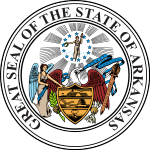| ||||||||||||||||||||||
Same-Sex Marriage Ban | ||||||||||||||||||||||
| Results | ||||||||||||||||||||||
|---|---|---|---|---|---|---|---|---|---|---|---|---|---|---|---|---|---|---|---|---|---|---|
| ||||||||||||||||||||||
 Yes 80–90% 70–80% 60–70% | ||||||||||||||||||||||
| Source: [1] [2] | ||||||||||||||||||||||
| Elections in Arkansas |
|---|
 |
Constitutional Amendment 3 of 2004, is an amendment to the Arkansas Constitution that makes it unconstitutional for the state to recognize or perform same-sex marriages or civil unions. The referendum was approved by 75% of the voters. [3]